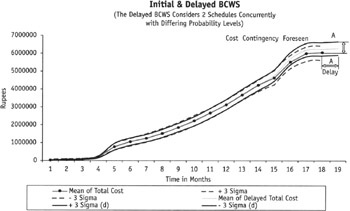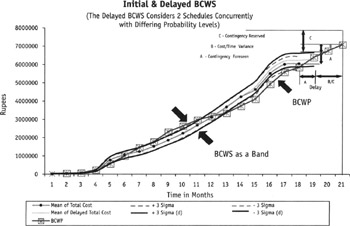Dealing with Contingency
|
Normally distribution of contingency is a subjective issue, in the hands of the project manager, but here it becomes part of the planning process—distinctively linked with the allowable threshold values to costs. This part of the contingency is something that the planning process foresees. Design and estimating variances, differences in site conditions, weather conditions, and probable delays and costs fall within the reasons of a foreseen contingency. The other type of contingency that should be kept is for unforeseen reasons.
Foreseen and Unforeseen Contingencies
When total foreseen contingency is fixed, it can be distributed equally between component activities or work packages or there could even be an uneven distribution for special reasons. The following is a statistically defined sensitivity analysis between end contingency and component contingencies. In case of even distribution of component contingencies,

where c is a constant contingency allowed in each activity
![]()
where C is a contingency allowed on total cost and μ=mean of total cost.
![]()
For example: for a 10 percent contingency, a total cost with 99.8 percent confidence


In case of unequal contingencies within work packages or activities,
![]()
So, we need to do a sensitivity analysis for finding c1, c2, c3, etc.—which are separate contingencies for separate activities.
There is a part of this foreseen contingency that needs to be dealt with using an understanding of probabilities. Suppose we see two possibilities in schedules beyond a certain time, say due to weather conditions. In our example project we were running into the monsoon (rainy) season during the middle of the program, which would affect some prime concreting activities and their curing times. So the barchart was loaded with both the first and second schedules at 50 percent probability levels. The second schedule is drawn on top of the first for activities where both are possible. This consideration of a foreseen vital variable and its probability brings us to a parallel yet concurrent consideration of two different schedules, as shown in Figure 4. Here, the delayed schedule is arrived at by reducing the respective costs by 50 percent wherever the two schedules overlap. The two schedules can be given two distinctly different probabilities also.

Figure 4: The Initial and Delayed BCWS
The selection of these kind of "vital few" variables and quantification of them in terms of their probabilistic effects on the project BCWS, takes care of uncertainty in terms of cost and schedule. Hence, the baseline should build in as much of the uncertainties and their consequences as is predictable. It helps us present our project life cycle like a walk through experience even before it has started. The "vital few" parameters, thus optimized, will convert the BCWS to a band or a polyline (a line with a thickness) so that the system now responds to deviant performance in a non-interacting way. Understanding the process of non-interacting and freely interacting variables is vital in separating the chaff from the variables of interest.
Apart from the foreseen contingency, which should be built into the schedule and planning, some amount of unforeseen contingency should be kept at hand on management reserve. Figure 5 shows the performance of the BCWP compared with the BCWS band made out of two schedules. The significance of the fall out of the contractor's performance is seen as the BCWP crossed the band and the second schedule actually took over. The project still had cost and time overruns. The schedule contingency was fully used up but some costs could be saved, thanks to a probabilistic understanding of the project and our robust process design, which had a built in insensitivity to surprises and deviations from standard operating conditions.

Figure 5: The BCWP against the Realistic Schedule
Lessons in "Non Conformance"—Do not Pursue the Nominal Value as Celebrated in the EVM Metrics—De-Emphasize Perfection
Performance measurement in a resource's constrained environment can no longer be "focussed on quality conformance" (Tapiero 1996), but should be focused on optimum performance. A good process control mechanism is more important than achieving the target on line, although it is highly likely to be achieved as a corollary, when such a system is in place. As Deming (1997) says, "A numerical goal accomplishes nothing. Only the method is important, not the goal." As the construction management profession struggles to establish a credibility in a world of unmet targets, nothing can be more important than the importance of a innovative, honest, and well-meaning effort in improving the process, especially when the system is often incapable of meeting its goals due to various constraints. The author's experience with various projects has reinforced the fact that processes are often in statistical control, yet fail to deliver the time and cost objectives because the demand supply imbalance of various economic situations generate corruption and collusion. We do not operate in the perfect competitive markets. The resultant uncertainty and unpredictability of the process causes variations, which are way beyond acceptable control limits. However, the system expectation tends to ignore the unquantified effects of these uncertainties, focussing on narrow specification limits. In such cases, some basic optimization and a study of the process show the systems to be predictably faltering; which in itself is a state of statistical control. As Deming (1997) says "a process could be in statistical control yet 100 percent defective. To go about reduction of fires, treating every fire as if it arose from a special cause, an accident, is totally different from regarding it as a product of a stable process. This supposition that every fire is an accident may well block the road to reduction in the number of fires." The solution lies only in the improvement of the process. Thus, it seems vital for EVM to accept "non-conformance." The BCWS as a nominal value in terms of time and cost is rather simplistic, and not worthwhile to pursue as an absolute number at the beginning of the process cycle. But it still remains relevant because, as the cycle matures and we make the system come near to its goal, we will be in a position to deliver the nominal value. And just as always, qualitative, quantitative, graphical, and statistical studies are required to provide insights and solutions, which cannot be detected just through visual and simplistic interpretation of data (Tapiero 1996).
|
EAN: 2147483647
Pages: 207